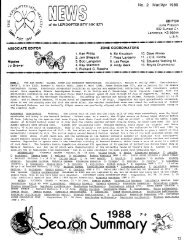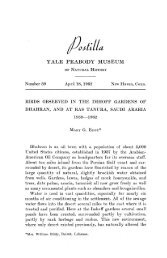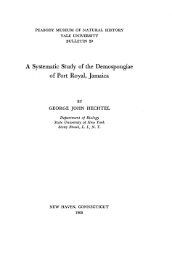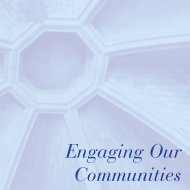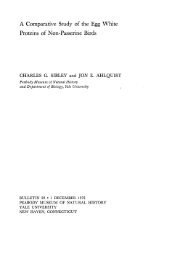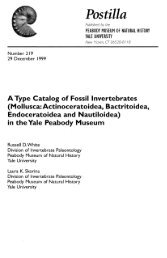Bulletin 3 - Peabody Museum of Natural History - Yale University
Bulletin 3 - Peabody Museum of Natural History - Yale University
Bulletin 3 - Peabody Museum of Natural History - Yale University
You also want an ePaper? Increase the reach of your titles
YUMPU automatically turns print PDFs into web optimized ePapers that Google loves.
20 PEABODY MUSEUM OF NATURAL HISTORYin true Mendelian fashion in the maturation <strong>of</strong> the gametes whichunited to produce the New Haven hybrid. Many <strong>of</strong> these geneswere able to exert almost their full influence, resulting in a birdwhich presents a remarkable mosaic <strong>of</strong> the two sets <strong>of</strong> parentalcharacters; for example, number <strong>of</strong> tail feathers, tarsal scalation,marking <strong>of</strong> tertials and scapulars. On the other hand,certain attributes appear as blends between homologous parentalstructures, e.g., size <strong>of</strong> bird, color <strong>of</strong> head, form <strong>of</strong> bill. Otherfeatures which are present in one parent and absent in the other,such as the two black breast bars, crest, lateral lamellae on beak,and vermiculations on flanks and sides, exist in the hybrid, buthave been modified somewhat in size, in form, or in both.While the same remarks apply to the hybrid from Maine, thecharacters are less well-defined owing to its immaturity.A comparative analysis <strong>of</strong> the two hybrids is given inTable III:Some characters which at first glance suggest that blendinghas occurred, upon analysis reveal the probability that they arein reality to be regarded as mosaics. For example, the head isentirely black in the New Haven hybrid, but incorporates theblack cheeks <strong>of</strong> Lophodytes and the black nape <strong>of</strong> Bucephala.From another point <strong>of</strong> view, neither the white cheek patches <strong>of</strong>the one nor the white crest patch <strong>of</strong> the other parent species wereable to develop. This may have been on account <strong>of</strong> a conflict<strong>of</strong> genes.When considering these matters, one should bear in mind theevident immaturity <strong>of</strong> the Maine hybrid, and the remote possibilitythat even the New Haven bird might in a following seasonhave developed more fully the pattern elements <strong>of</strong> one or bothparent species.Table III may be summarized as follows:No. <strong>of</strong> characters No. <strong>of</strong> blended No. <strong>of</strong> charactersfavoring characters favoringLophodytesBucephalaNew Haven Hybrid... 6% 3 - 7%Maine Hybrid 6% 3 5



